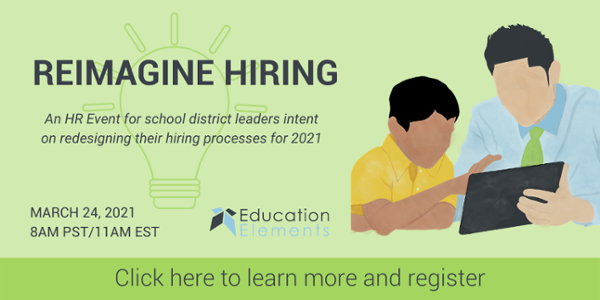A few Fridays ago I got a message from my colleague Kelly. She asked what I wanted for lunch, said she would order it, and that we would eat together during our Zoom meeting later that day (where we would begin to reimagine what summer school could look like). This simple and thoughtful act changed my mood in the moment and for the rest of that day.
Kelly went out of her way to shape my experience and my team’s experience for our meeting, but also for the project we were about to start together. At the end of that day, I was reflecting on her generosity and consideration for our team. I thought about how I can and should be doing more of that for members of my team – being intentional about shaping their experiences.
Through intentional, simple, and low-cost methods, we can create a better employee experience for ourselves and our teammates. “Employee experience” is a relatively new idea in the HR world and has gained traction over the past decade. It accounts for everything that an employee experiences, from initial application to onboarding, to job training, to every meeting and interaction. It couples human resources best practices around retention and engagement (think wellness, coaching, support, benefits) with customer experience design.
For ages, companies and organizations have invested millions of dollars thinking through exactly why and how they will create a positive experience so that customers are happy, loyal, and have their needs met. From this line of thinking, many leaders started asking, “why aren’t we doing this for our employees too?”
Research has shown that organizations that prioritize employee experience outperform their competitors. Employee experience design has a foothold in large technology companies like IBM, Airbnb, and Google – and this has only been in the past decade.
Without a doubt, 2020 and the first few weeks of 2021 have transformed what the teacher experience looks and feels like. School and district leaders have been inundated by changing conditions and constant adaptation. This has left little time to reflect, process, and get a firm grasp on what the new teacher experience looks like at their schools and in their communities. Often in education, teacher experience is an afterthought that is overshadowed by compliance, accountability, and bureaucratic efficiency. If districts want to be desirable employers who keep their teachers, then teacher experience design must have a place in its philosophy and operations. To get you started, below are a few strategies to help you begin to understand and shape the teacher experience by design.
Often in education, teacher experience is an afterthought overshadowed by compliance, accountability, and bureaucratic efficiency. If districts want to be desirable employers, teacher experience design must have a place in its philosophy and operations.
Understand the Teacher Journey
Experience design often centers on and builds from the user journey. In this case, our “users” are teachers. Leaders and teachers can come together to map out the current state of the journey – either for all phases of the teacher journey from recruitment to retirement (see the image below) or for a single touchpoint within that journey (e.g., district-wide back-to-school event).
Journey maps include specific touchpoints, teachers’ expectations, and the emotions that a teacher experiences during a specific touchpoint or phase of their career. One way to leverage journey maps is by capturing both the current experience and the ideal experience for a specific phase or touchpoint. For example, if retention data shows that a high percentage of new teachers leave the district after year 3, you might consider redesigning the onboarding experience. This does not just mean adjusting the skills and knowledge taught through professional development, but it should also include how you want teachers to feel at different stages of their onboarding journey. For example, to increase feelings of belonging throughout year one you might add cross-school support groups, a weekly check-in with a mentor, and a series of special events aimed at community-building for new teachers.
Build Empathy to Influence the Teacher Experience
A critical aspect of experience design is building empathy for the user. This can raise awareness about how teachers perceive specific aspects of their experience. Interviews, focus groups, and observations are common approaches to building empathy and a better understanding of how a teacher feels and navigates their school day.
One tactic you can use to both increase your empathy and that of the team is by using a simple quick write. At your next staff meeting, ask each teacher to spend ten minutes writing down what their morning was like. Ask them to share as much as they are comfortable sharing – what they ate for breakfast, how they felt when arriving at school, a specific moment with a student, an experience during a team meeting. Next, ask each teacher to pass their quick write to a team, then read and respond. Do this for two or three rounds. After, take thirty minutes to read through the quick writes. What do you notice? How do teachers feel about their mornings? What surprised you? What did you expect or hope for that seems to be missing? What patterns do you see? Is there a small change you can make to improve teachers’ daily lives?
Start Small and Start Soon
Whether your school or district takes a more strategic and aspirational approach to teacher experience or not, there are a few things you can do right now to positively impact the teacher experience.
-
Quick Write - Use the quick write exercise at your next staff meeting. While systemic changes may not be on the horizon, this exercise signals to teachers that you care about their day-to-day experience, and will help you uncover what needs to be addressed.
-
Call a Teacher - Pick up the phone and call a teacher. Ask how they are doing, what is going well, and how you can support them. If this is a new practice for you, some teachers might be shocked and confused that you called, but in the end, they will appreciate that you reached out.
-
Surprise your Staff - Unexpected delight can create peak moments for teachers. A single peak moment tends to outweigh the negative experiences of the day in our memories. What can you do to delight a single teacher, group, or your whole staff? A funny video message, offering to teach a class and give them some planning time, or surprising them with a lunch order can go a long way in improving their experience.
I often hear from district leaders and principals, “education is always 10 years behind business”. That might be true now, but it does not have to be. By raising awareness about the teacher experience and prioritizing a few core strategies, schools and districts can begin to improve the teacher experience. And, bonus – when teachers have a more positive and productive experience as employees, their students will also have a more positive and productive experience as learners.





